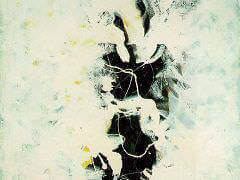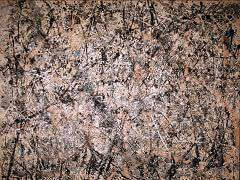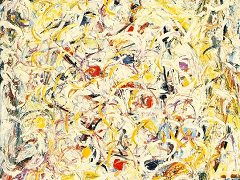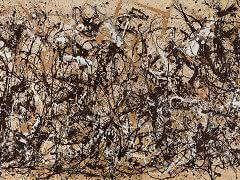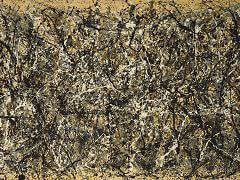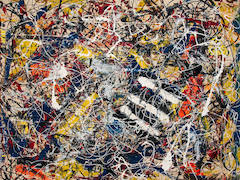Biography of Jackson Pollock

Jackson Pollock (January 28, 1912 - August 11, 1956), was an influential American painter and a major figure in the abstract expressionist movement. During his lifetime, Pollock enjoyed considerable fame and notoriety. He was regarded as a mostly reclusive artist. He had a volatile personality, and struggled with alcoholism for most of his life. In 1945, he married the artist Lee Krasner, who became an important influence on his career and on his legacy. Pollock died at the age of 44 in an alcohol-related car accident. In December 1956, he was given a memorial retrospective exhibition at the Museum of Modern Art (MoMA) in New York City, and a larger more comprehensive exhibition there in 1967. More recently, in 1998 and 1999, his work was honored with large-scale retrospective exhibitions at MoMA and at The Tate in London.
Early Life
Pollock was born in Cody, Wyoming in 1912, the youngest of five sons. His parents, Stella May McClure and Leroy Pollock, grew up in Tingley, Iowa. His father had been born McCoy but took the surname of his
neighbors, who adopted him after his own parents had died within a year of each other. Stella and LeRoy Pollock were Presbyterian; the former, Irish; the latter, Scotch-Irish. LeRoy Pollock was a farmer and
later a land surveyor for the government. Jackson grew up in Arizona and Chico, California.
While living in Echo Park, California, he enrolled at Los Angeles' Manual Arts High School, from which he was expelled,
after having been expelled another high school in 1928. During his early life, he experienced Native American culture while on surveying trips with his father. In 1930, following his brother Charles Pollock,
he moved to New York City where they both studied under Thomas Hart Benton at the Art Students League of New York. Benton's rural American subject matter shaped Pollock's work only fleetingly, but his rhythmic
use of paint and his fierce independence were more lasting influences. From 1938 to 1942, Pollock worked for the WPA Federal Art Project.
In attempts to fight his alcoholism, from 1938 through 1941 Pollock underwent Jungian psychotherapy with Dr. Joseph Henderson and later with Dr. Violet Staub de Laszlo in 1941-1942. Dr. Henderson was an eclectic who drew upon
the spectrum of psychoanalytic theory, including Freud and Jung. Henderson made the decision to engage him through his art and had Pollock make drawings, which led to the appearance
of many Jungian concepts in his paintings. Recently it has been hypothesized that Pollock might have had bipolar disorder.
The Springs period and the unique technique
In October 1945 Pollock married American painter Lee Krasner, and in November they moved to what is now known as the Pollock-Krasner House and Studio, at 830 Springs Fireplace Road, in Springs on Long Island, NY. Peggy Guggenheim lent them the down payment for the wood-frame house with a nearby barn that Pollock converted into a studio. There he perfected the technique of working with paint with which he became permanently identified.
Pollock was introduced to the use of liquid paint in 1936 at an experimental workshop operated in New York City by the Mexican muralist David Alfaro Siqueiros. He later used paint pouring as one of several techniques
on canvases of the early 1940s, such as "Male and Female" and "Composition with Pouring I." After his move to Springs, he began painting with his canvases laid out on the studio floor, and he developed what was later
called his "drip" technique, turning to synthetic resin-based paints called alkyd enamels, which, at that time, was a novel medium. Pollock described this use of household paints, instead of artist's paints, as "a
natural growth out of a need." He used hardened brushes, sticks, and even basting syringes as paint applicators. Pollock's technique of pouring and dripping paint is thought to be one of the origins of the term action
painting. With this technique, Pollock was able to achieve a more immediate means of creating art, the paint now literally flowing from his chosen tool onto the canvas. By defying the convention of painting on an upright
surface, he added a new dimension by being able to view and apply paint to his canvases from all directions. One possible influence on Pollock was the work of the Ukrainian American artist Janet Sobel (1894-1968)
(born Jennie Lechovsky). Sobel's work is related to the so-called "drip paintings" of Jackson Pollock. Peggy Guggenheim included Sobel's work in her The Art of This Century Gallery in 1945. The critic Clement Greenberg,
with Jackson Pollock, saw Sobel's work there in 1946, and in his essay "American-Type' Painting" Greenberg cited those works as the first instance of all-over painting he had seen, stating that "Pollock admitted that
these pictures had made an impression on him".
In the process of making paintings in this way, he moved away from figurative representation, and challenged the Western tradition of using easel and brush. He also moved away from the use of only the hand and wrist, since
he used his whole body to paint. In 1956, Time magazine dubbed Pollock "Jack the Dripper" as a result of his unique painting style.
My painting does not come from the easel. I prefer to tack the unstretched canvas to the hard wall or the floor. I need the resistance of a hard surface. On the floor I am more at ease. I feel nearer, more part
of the painting, since this way I can walk around it, work from the four sides and literally be in the painting”
-Jackson Pollock, My Painting
When I am in my painting, I'm not aware of what I'm doing. It is only after a sort of 'get acquainted' period that I see what I have been about. I have no fear of making changes, destroying the image, etc.,
because the painting has a life of its own. I try to let it come through. It is only when I lose contact with the painting that the result is a mess. Otherwise there is pure harmony, an easy give and take, and the painting
comes out well.”
-Jackson Pollock, My Painting
Pollock observed Indian sandpainting demonstrations in the 1940s. Other influences on his dripping technique include the Mexican muralists and Surrealist automatism. Pollock denied "the accident"; he usually had an idea of
how he wanted a particular piece to appear. His technique combined the movement of his body, over which he had control, the viscous flow of paint, the force of gravity, and the absorption of paint into the canvas. It was a
mixture of controllable and uncontrollable factors. Flinging, dripping, pouring, and spattering, he would move energetically around the canvas, almost as if in a dance, and would not stop until he saw what he wanted to see.
Studies by Taylor, Micolich and Jonas have examined Pollock's technique and have determined that some works display the properties of mathematical fractals. They assert that the works become more fractal-like chronologically
through Pollock's career. The authors even speculate that Pollock may have had an intuition of the nature of chaotic motion, and attempted to form a representation of mathematical chaos, more than ten years before "Chaos
Theory" itself was proposed. Other experts suggest that Pollock may have merely imitated popular theories of the time in order to give his paintings a depth not previously seen.
The 1950s
Pollock's most famous paintings were made during the "drip period" between 1947 and 1950. He rocketed to popular status following an August 8, 1949 four-page spread in Life magazine that asked, "Is he the greatest living painter in the United States?" At the peak of his fame, Pollock abruptly abandoned the drip style.
Pollock's work after 1951 was darker in color, including a collection painted in black on unprimed canvases. This was followed by a return to color, and he reintroduced figurative elements. During this period Pollock had moved to a more commercial gallery and there was great demand from collectors for new paintings. In response to this pressure, along with personal frustration, his alcoholism deepened.
Death
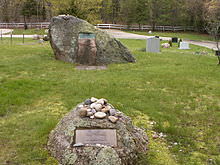
In 1955, Pollock painted Scent and Search which would be his last two paintings. Pollock did not paint at all in 1956. After struggling with alcoholism for his entire adult life, Pollock, on August 11, 1956, at 10:15 pm, died in a single-car crash in his Oldsmobile convertible while driving under the influence of alcohol. One of the passengers, Edith Metzger, was also killed in the accident, which occurred less than a mile from Pollock's home. The other passenger, Pollock's mistress Ruth Kligman, survived. After Pollock's demise at age 44, his widow, Lee Krasner, managed his estate and ensured that Pollock's reputation remained strong despite changing art-world trends. They are buried in Green River Cemetery in Springs with a large boulder marking his grave and a smaller one marking hers.



